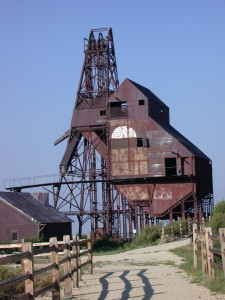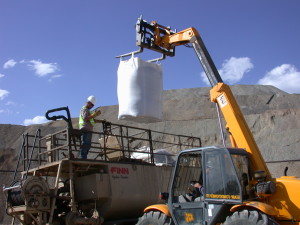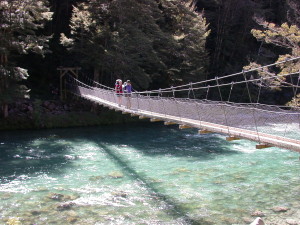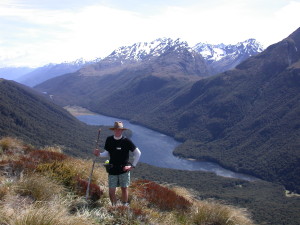17 Jun 2013
Doing It Once, Doing It Right
The extraction of minerals and energy from the earth invariably necessitates a disturbance of pristine environment. That is in direct conflict with an often-overlooked best management practice (BMP) for controlling erosion: don’t disturb the soil in the first place.
Fortunately, the emphasis of the extractive industries has changed significantly over the past two decades since I first entered the reclamation business. Traditionally mining companies had focused on managing a mineral resource. The game has changed to the point they now acknowledge they also have a broader natural resource to manage. Increasingly mining companies are tackling the formidable task of measuring and reporting both their positive and negative long-term impact on the environment and society.
 Why? A company cannot find and extract minerals if it cannot access land. Part of the price for gaining future access to land is to meet stakeholder expectations about how companies should currently be managing their land. The strong message our environmentally enlightened society is sending to companies who must disturb the land is that approvals for future projects will only be won if the company can demonstrate that they are appropriately managing current projects. Regulatory pressure supplying teeth to this societal pressure is increasing almost everywhere.
Why? A company cannot find and extract minerals if it cannot access land. Part of the price for gaining future access to land is to meet stakeholder expectations about how companies should currently be managing their land. The strong message our environmentally enlightened society is sending to companies who must disturb the land is that approvals for future projects will only be won if the company can demonstrate that they are appropriately managing current projects. Regulatory pressure supplying teeth to this societal pressure is increasing almost everywhere.
Accordingly, in the pursuit of demonstrating good stewardship of the environment it becomes critically important to implement successful reclamation in a timely manner. Progressive, successful reestablishment of the native environment is critical to demonstrating a mine’s operational capability, and to creating confidence among stakeholders about current and future mine projects.
At Quattro, we have long stated that “Doing it once, doing it right” is the most cost-effective way to manage reclamation activities. Empirical data now exists highlighting the economic benefits of completing reclamation successfully the first time around. Reclamation failures can result in a 50% cost increase over the cost of planning for and implementing proper, and successful, reclamation techniques from the outset of the project. Or to put it another way, the low bid (as opposed to best value) option is notoriously the most expensive way to discharge one’s reclamation obligations.
The study addresses the economic impacts associated with both the direct costs and indirect costs of unsuccessful reclamation. The significant economic impacts associated with the direct costs reflect the additional earthwork for sediment clean-up and regrading, the costs of importing topsoil or applying soil amendments when poor soil conditions generate initial revegetation failures, the obvious repeat costs of re-seeding and re-installation of erosion control products, and the costs of weed control.
 The hidden indirect costs include environmental manager and consultant time to coordinate reclamation work that needs to be redone, potential agency fines for stormwater management violations, and potential lost opportunity cost due to poor agency and landowner relationships that delay mineral extraction.
The hidden indirect costs include environmental manager and consultant time to coordinate reclamation work that needs to be redone, potential agency fines for stormwater management violations, and potential lost opportunity cost due to poor agency and landowner relationships that delay mineral extraction.
The study highlighted the importance of the need for environmental managers to set up a system for cost data collection to establish credible reclamation budgets. Providing reasonable estimates for reclamation activities that can be applied to capitalizing reclamation costs up front on future projects would ensure resource protection. Economic Benefits of Completing Reclamation Successfully the First Time for Oil & Gas Sites
11 Jun 2013
Passion for Implementing Successful Reclamation
As project manager for your agency’s reclamation project your focus may be on immediate erosion control via both hardscape and softscape best management practices. While immediate erosion control is a worthy goal, long-term erosion control is only attained by the re-establishment of sustainable native plant growth, invariably on soils that have been drastically disturbed. You may be lucky enough to be dealing with drastically disturbed topsoil. More likely, the term “drastically disturbed soils” will unfortunately be a euphemism for “all topsoil has vanished!” If so, accomplishing your objective can be tricky, as evidenced by the plethora of reclamation seeding project disappointments scattered throughout the arid Western U.S.
Take heart. From reviewing www.quattroenvironmental.com you have an understanding that the key to re-establishing long-term sustainable native plant growth has less to do with growing plants, than it has to do with restoring a functioning soil community beneath those plants. And as you embrace the Quattro LSM Growing Soil technologies, your first assignment becomes: How best to go about restoring a functioning soil community – on drastically disturbed soils – in a harsh environment?
 The glib answer is “Very carefully”. Perhaps more helpfully, it is important to realize at the outset that Nature is intolerant of weak links. Weak links are found in both under-performing design technologies, and in flawed project implementation. Conventional “band-aid” seeding practices are an example of a design technology weak link. Our industry’s obsession with design implementation by an unsupervised low bidder is a classic example of a flawed project implementation weak link. Both guarantee project disappointment. Fortunately, there are talented experts who are willing to lend you a hand in navigating the multitude of tasks that must be performed flawlessly.
The glib answer is “Very carefully”. Perhaps more helpfully, it is important to realize at the outset that Nature is intolerant of weak links. Weak links are found in both under-performing design technologies, and in flawed project implementation. Conventional “band-aid” seeding practices are an example of a design technology weak link. Our industry’s obsession with design implementation by an unsupervised low bidder is a classic example of a flawed project implementation weak link. Both guarantee project disappointment. Fortunately, there are talented experts who are willing to lend you a hand in navigating the multitude of tasks that must be performed flawlessly.
Quattro Environmental has assembled an alliance of professionals – clients, designers, suppliers and applicators – with the skills, resources and passion to ensure a “Do It Once, Do It Right” project outcome.
The Quattro Alliance has more than academic credentials, skills and resources. The team has a track record of consistently re-establishing native plant growth on drastically disturbed soils in harsh environments. They will be able to assist you in replicating this track record of success on your soils, and in your climate.
But equally importantly, the Quattro Alliance team members each have a passion for succeeding at rehabilitating the environment. Their passion is born out of love for the environment that inspires them to go that extra mile when circumstances (or Nature) demand it.
 What fuels this passion? For one of our team members, it is the sense of awe when in the presence of true wilderness, like hiking down the Grand Canyon. For another, it is the joy of witnessing the fruits of intelligent reclamation — seeing a barren landscape come to life again, and watching wildlife move back in. Some of the photos on our home page were taken by a team member who captures his reverence and exhilaration for western landscapes through photography. For me, well, I was lucky enough to be raised in New Zealand, a land of pristine, rugged beauty. The photos (right) are from the Grand Traverse trek in the South Island of New Zealand. This six-day hike is like walking on the earth the day after its creation. Healing the earth and restoring its natural magnificence is what fuels my passion. What fuels yours?
What fuels this passion? For one of our team members, it is the sense of awe when in the presence of true wilderness, like hiking down the Grand Canyon. For another, it is the joy of witnessing the fruits of intelligent reclamation — seeing a barren landscape come to life again, and watching wildlife move back in. Some of the photos on our home page were taken by a team member who captures his reverence and exhilaration for western landscapes through photography. For me, well, I was lucky enough to be raised in New Zealand, a land of pristine, rugged beauty. The photos (right) are from the Grand Traverse trek in the South Island of New Zealand. This six-day hike is like walking on the earth the day after its creation. Healing the earth and restoring its natural magnificence is what fuels my passion. What fuels yours?

